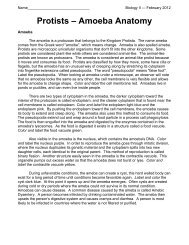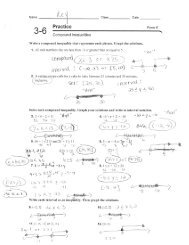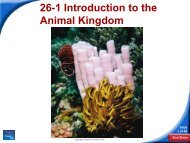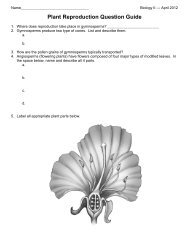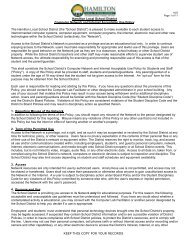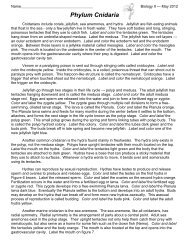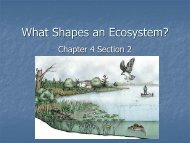26-3 Cnidarians - Hamilton Local Schools
26-3 Cnidarians - Hamilton Local Schools
26-3 Cnidarians - Hamilton Local Schools
Create successful ePaper yourself
Turn your PDF publications into a flip-book with our unique Google optimized e-Paper software.
<strong>26</strong>-3 <strong>Cnidarians</strong>Slide1 of 47Copyright Pearson Prentice Hall
<strong>26</strong>-3 <strong>Cnidarians</strong>What Is a Cnidarian?What is a cnidarian?Slide2 of 47Copyright Pearson Prentice Hall
<strong>26</strong>-3 <strong>Cnidarians</strong>What Is a Cnidarian?What Is a Cnidarian?<strong>Cnidarians</strong> are soft-bodied, carnivorousanimals that have stinging tentaclesarranged in circles around their mouths.They are the simplest animals to havebody symmetry and specialized tissues.Slide3 of 47Copyright Pearson Prentice Hall
<strong>26</strong>-3 <strong>Cnidarians</strong>What Is a Cnidarian?<strong>Cnidarians</strong> get their name from thecnidocytes, or stinging cells, located alongtheir tentacles.<strong>Cnidarians</strong> use cnidocytes for defense and tocapture prey.Slide4 of 47Copyright Pearson Prentice Hall
<strong>26</strong>-3 <strong>Cnidarians</strong>What Is a Cnidarian?Within each cnidocyteis a nematocyst—apoison-filled, stingingstructure that containsa tightly coiled dart.TriggerFilamentNematocyteBarbFilamentSlide5 of 47Copyright Pearson Prentice Hall
<strong>26</strong>-3 <strong>Cnidarians</strong>What Is a Cnidarian?When a shrimp or smallfish brushes up againstthe tentacles, thousandsof nematocysts explode,releasing enough poisonto paralyze or kill theprey.Slide6 of 47Copyright Pearson Prentice Hall
<strong>26</strong>-3 <strong>Cnidarians</strong>Form and Function in <strong>Cnidarians</strong>What two body plans exist in the cnidarianlife cycle?Slide7 of 47Copyright Pearson Prentice Hall
<strong>26</strong>-3 <strong>Cnidarians</strong>Form and Function in <strong>Cnidarians</strong>Form and Function in <strong>Cnidarians</strong><strong>Cnidarians</strong> are radially symmetrical. They have acentral mouth surrounded by numerous tentaclesthat extend outward from the body.Slide8 of 47Copyright Pearson Prentice Hall
<strong>26</strong>-3 <strong>Cnidarians</strong>Form and Function in <strong>Cnidarians</strong><strong>Cnidarians</strong> typically have a life cycle thatincludes two different-looking stages: apolyp and a medusa.PolypMedusaSlide9 of 47Copyright Pearson Prentice Hall
<strong>26</strong>-3 <strong>Cnidarians</strong>Form and Function in <strong>Cnidarians</strong>A polyp is a cylindricalbody with armliketentacles. In a polyp, themouth points upward.Polyps are usuallysessile.PolypSlide10 of 47Copyright Pearson Prentice Hall
<strong>26</strong>-3 <strong>Cnidarians</strong>Form and Function in <strong>Cnidarians</strong>A medusa has a motile,bell-shaped body with themouth on the bottom.MedusaSlide11 of 47Copyright Pearson Prentice Hall
<strong>26</strong>-3 <strong>Cnidarians</strong>Form and Function in <strong>Cnidarians</strong>Cnidarian polyps and medusas each have a bodywall that surrounds an internal space called agastrovascular cavity.GastrovascularcavityGastrovascularcavitySlide12 of 47Copyright Pearson Prentice Hall
<strong>26</strong>-3 <strong>Cnidarians</strong>Form and Function in <strong>Cnidarians</strong>The gastroderm is the inner lining of thegastrovascular cavity, where digestion takes place.Gastrovascular cavityGastrovascular cavitySlide13 of 47Copyright Pearson Prentice Hall
<strong>26</strong>-3 <strong>Cnidarians</strong>Form and Function in <strong>Cnidarians</strong>The epidermis is the outer layer of cells.EpidermisEpidermisSlide14 of 47Copyright Pearson Prentice Hall
<strong>26</strong>-3 <strong>Cnidarians</strong>Form and Function in <strong>Cnidarians</strong>The mesoglea is a layer that lies between theepidermis and gastroderm.MesogleaSlide15 of 47Copyright Pearson Prentice Hall
<strong>26</strong>-3 <strong>Cnidarians</strong>Form and Function in <strong>Cnidarians</strong>FeedingA cnidarian pulls its food through its mouth andinto its gastrovascular cavity, a digestivechamber with one opening.Food enters and wastes leave the body throughthat same opening.Slide16 of 47Copyright Pearson Prentice Hall
<strong>26</strong>-3 <strong>Cnidarians</strong>Form and Function in <strong>Cnidarians</strong>The digestion that occurs in the gastrovascular cavityis extracellular, meaning that it takes place outside ofcells.Partially digested food is absorbed by thegastroderm.Digestion is completed intracellularly, within cells inthe gastroderm.Any materials that cannot be digested are passed outof the body through the mouth.Slide17 of 47Copyright Pearson Prentice Hall
<strong>26</strong>-3 <strong>Cnidarians</strong>Form and Function in <strong>Cnidarians</strong>Respiration, Circulation, and ExcretionFollowing digestion, nutrients are usuallytransported throughout the body by diffusion.<strong>Cnidarians</strong> respire and eliminate the wastes ofcellular metabolism by diffusion through their bodywalls.Slide18 of 47Copyright Pearson Prentice Hall
<strong>26</strong>-3 <strong>Cnidarians</strong>Form and Function in <strong>Cnidarians</strong>Response<strong>Cnidarians</strong> gather information from theirenvironment using specialized sensory cells.Slide19 of 47Copyright Pearson Prentice Hall
<strong>26</strong>-3 <strong>Cnidarians</strong>Form and Function in <strong>Cnidarians</strong>Both polyps and medusashave a nerve net, aloosely organizednetwork of nerve cells.Nerve cellsSlide20 of 47Copyright Pearson Prentice Hall
<strong>26</strong>-3 <strong>Cnidarians</strong>Form and Function in <strong>Cnidarians</strong>ReproductionMost cnidarians reproduce both sexually andasexually.Polyps can reproduce asexually by budding.In most cnidarians, sexual reproduction takesplace with external fertilization. Externalfertilization takes place outside the female's body.Slide21 of 47Copyright Pearson Prentice Hall
<strong>26</strong>-3 <strong>Cnidarians</strong>Form and Function in <strong>Cnidarians</strong>In the life cycle of Aurelia, a common jellyfish, thefemale releases eggs into the water, and the malereleases sperm.Slide22 of 47Copyright Pearson Prentice Hall
<strong>26</strong>-3 <strong>Cnidarians</strong>Form and Function in <strong>Cnidarians</strong>Fertilization occurs in open water.Each zygote grows into a free-swimminglarva.Slide23 of 47Copyright Pearson Prentice Hall
<strong>26</strong>-3 <strong>Cnidarians</strong>Form and Function in <strong>Cnidarians</strong>The larva eventuallyattaches to a hardsurface and develops intoa polyp.Slide24 of 47Copyright Pearson Prentice Hall
<strong>26</strong>-3 <strong>Cnidarians</strong>Form and Function in <strong>Cnidarians</strong>The polyp eventuallybuds and releases youngmedusas that begin thecycle again.Slide25 of 47Copyright Pearson Prentice Hall
<strong>26</strong>-3 <strong>Cnidarians</strong>Groups of <strong>Cnidarians</strong>What are the three groups of cnidarians?Slide<strong>26</strong> of 47Copyright Pearson Prentice Hall
<strong>26</strong>-3 <strong>Cnidarians</strong>Groups of <strong>Cnidarians</strong>Groups of <strong>Cnidarians</strong><strong>Cnidarians</strong> include:• jellyfishes• hydras and their relatives• sea anemones and coralsSlide27 of 47Copyright Pearson Prentice Hall
<strong>26</strong>-3 <strong>Cnidarians</strong>Groups of <strong>Cnidarians</strong>JellyfishesThe Class Scyphozoa contains the jellyfishes.Jellyfishes live their lives primarily as medusas.The polyp form of jellyfishes is restricted to a smalllarval stage, and no elaborate colonies ever form.Jellyfishes reproduce sexually.Slide28 of 47Copyright Pearson Prentice Hall
<strong>26</strong>-3 <strong>Cnidarians</strong>Groups of <strong>Cnidarians</strong>Hydras and Their RelativesThe Class Hydrozoa contains hydras and relatedanimals.The polyps of most hydrozoans grow in branchingcolonies that can extend more than a meter.Within the colony, polyps are specialized toperform different functions.Slide29 of 47Copyright Pearson Prentice Hall
<strong>26</strong>-3 <strong>Cnidarians</strong>Groups of <strong>Cnidarians</strong>Sea Anemones and CoralsThe Class Anthozoa contains sea anemones andcorals, animals that have only the polyp stage intheir life cycle.Anthozoans all have a central body surrounded bytentacles.Slide30 of 47Copyright Pearson Prentice Hall
<strong>26</strong>-3Continue to:- or -Click to Launch:Slide31 of 47Copyright Pearson Prentice Hall
<strong>26</strong>-3The characteristic that defines the cnidarians isa. bilateral symmetry.b. stinging cells.c. a gastrovascular cavity.d. cephalization.Slide32 of 47Copyright Pearson Prentice Hall
<strong>26</strong>-3Which of the following statements is generallytrue of polyps and medusas?a. Polyps are sessile, and medusas are motile.b. Polyps are motile, and medusas are sessile.c. Both polyps and medusas are sessile.d. Both polyps and medusas are motile.Slide33 of 47Copyright Pearson Prentice Hall
<strong>26</strong>-3During the life cycle of Aurelia, the zygote growsinto a free-swimminga. polyp.b. larva.c. medusa.d. gemmule.Slide34 of 47Copyright Pearson Prentice Hall



